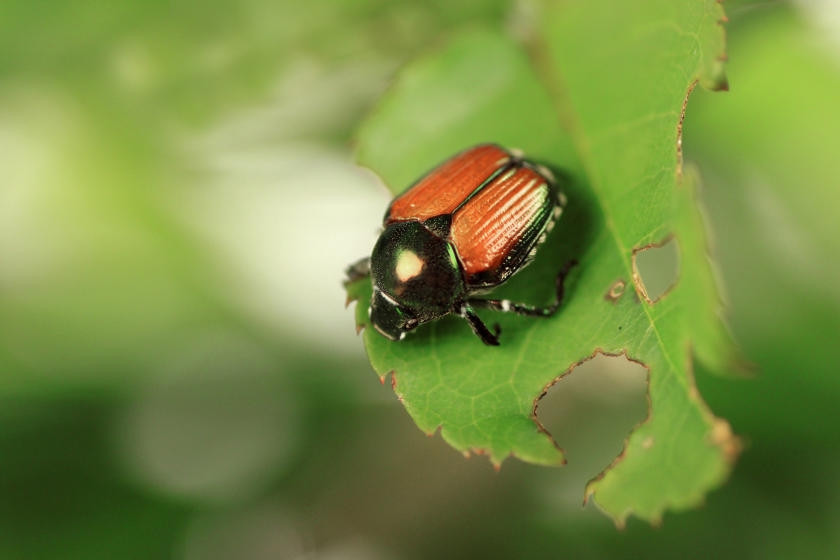An appealing garden is always sure to attract attention. However, sometimes that means there will be unwanted interest from insects and animals. To keep your garden healthy and productive, follow the simple steps below to control even the most stubborn garden pests.
Step 1: Know What You’re Up Against
Understanding what pests are damaging your lawn and garden is half the battle. If you don’t know what you’re fighting, you risk not using the most effective methods to rid your garden of unwanted insects and animals.
Insects
The following are some of the most common garden-damaging insects around the country:
- Aphids – Tiny yellowish-green lice found clustered on tender plant shoots, aphids stunt a plant’s growth by sucking its juices, which cause leaves to curl. If left untreated, they can multiply at an extremely rapid rate.
- Japanese beetles – Destructive red and green insects that feed on flowers and leaves.
- Slugs and snails – Usually come out at night to eat low-hanging leaves.
- Leaf miners – Larvae of certain flies or beetles that feed on material within the lining of leaves.
- Spider mites – These common insects are very tiny and often white or red. Spider mites can cause widespread discoloration and deformities in many plants.
- Leafhoppers – Quarter-inch-sized green insects that suck the sap from leaves and destroy them.
- Caterpillars – Love to eat leaves. An infestation can completely defoliate plants and trees, and they can also be a problem for lawns in some areas of the country.
- Grasshoppers – These bugs can cause a lot of damage to plant leaves, but they can also make holes in other plant tissues. They love to eat beans, lettuce, corn and carrots. The good news, for those with a small garden, is that plants can withstand grasshopper feeding because their numbers won’t be as large as those that feed on large plots and fields of crops.
- Earwigs – They can feed on shoots and leaves, and sometimes flowers, but they don’t do a lot of damage. In fact, they can often be a benefit to your garden because they feed on aphids, snails and some types of larvae.
- Grubs – The larvae of many different kinds of insects that can do a lot of damage to lawns and the foliage of garden plants.
Helpful Tip
Don’t fret over the appearance of ladybugs, spiders, bees, or wasps. These are beneficial garden insects.
Animals
Depending on where you live, you may also notice small animals in your garden. These may include:
- Rabbits and squirrels – These cute critters can destroy the tops of plants or even entire plants.
- Birds – Crows and blue jays eat corn, seeds and seedlings, fruits, berries and nuts.
- Moles, chipmunks, mice and groundhogs – Like rabbits and squirrels, these animals can nibble away on leaves, stems and crops.
- Deer – If you live in an area that has a large deer population, chances are good that deer may wander onto your property for a taste of fresh vegetables.
Step 2: Look for Warning Signs
Even if you don’t catch insects and animals in the act, there are still ways to determine if pests are affecting your garden. If you notice holes in leaves, your plants may be under attack from snails, grasshoppers or other insects. You may also notice an abundance of brown or yellow spots on leaves. Spider mites often can be the cause of leaf wilting. The holes they make are too small to see with the naked eye, but you should take note of wilting leaves. You may also notice stunted plant, fruit or crop growth or no growth at all. When insects attack the leaves of plants, they reduce the plant’s ability to take in needed sunlight. Insects, such as grubs, that attack roots prevent plants from taking in nutrients. Carefully examine your plants for live insects above and below the soil’s surface.
Helpful Tips
Apply a soap flush to your soil. Add 2 teaspoons of dishwashing detergent to 1 gallon of water in a bucket. Pour the mixture over a 2′ x 2′ area of your garden’s soil. The flush will irritate insects feeding below the surface, forcing them to rise to the top. Once you have some specimens, place them in plastic bags so you can identify them.
Gently shake plants over a white piece of paper. Then use a magnifying glass to find and identify any small insects that may have been hiding on stems and leaves.
Signs of animal intruders are usually more obvious. Plants may look nibbled on or completely eaten, uprooted or trampled.
Step 3: Use Natural Deterrents
You don’t need harsh chemical pesticides to protect your garden from pesky insects and animals. Insect removal for small infestations is easy. Just carefully pick them off with gloved fingers. Many insects are also easily repelled by soapy water applied with a sponge or a spray bottle. Consider using milky spore grub control formulas. A milky spore is a type of natural bacteria that infects different kinds of grubs. Apply milky spores in the spring and fall for best results. Milky spores are harmless to vegetables and flower gardens. Note that birds and other wildlife are also immune to the effects of this organic pest control.
Row covers prevent insects from landing and planting eggs. It’s the insect larvae that can be highly detrimental to crops. Covers also add protection against frost. Sticky traps attract and catch many flying insects that might land on vegetation. Microbial insecticides and horticultural oils work well on caterpillars, aphids and other insects that feed on vegetation. These oils are less toxic to people or animals and break down easily. Do some research on what works best for the particular pest you are trying to get rid of so you aren’t using unnecessary additives on your garden. Healthy plants are strong plants; sick plants are more susceptible to attack from pests. Keep your garden healthy by catching diseases early on. Most often caused by fungi, bacteria and viruses, plant diseases usually show up as leaf spots, lesions or wilting. Inspect your plants regularly to prevent damage and disease. If you catch infestations or ailments early, it is easier to reverse any harm done. Knowing what you’re up against is essential to applying the right remedy.
Here are some things to try in order to prevent plant disease:
- Whenever possible, use disease-tolerant plants.
- Be sure that your garden has plenty of moisture, but avoid over-watering. Overly wet soil causes root rot and other diseases.
- Rotate crops. Planting the same crops year after year in the same soil helps disease organisms thrive. For best results, try not to plant vegetables from the same botanical family in the same parcel of soil for at least three years.
- Properly space plants. Too many plants in one area can increase the chance of disease. Increase space between plants so air and light reaches everything equally. This will also prevent disease from spreading through proximity.
- Destroy infected plants. Pull up any plants that show severe disease symptoms so they don’t spread the infection to adjacent plantings.
Deer, rabbits, squirrels and woodchucks are liable to take full advantage of your garden if your property lies near fields or woods. Spray animal repellent onto foliage for temporary relief from this problem. For lasting results consider using fences, mesh or trellis netting to prevent small animals from entering your garden.
Another approach to repel animals is to plant vegetation they dislike. Rabbits will generally avoid peppers, tomatoes, corn, cucumbers and squash. Deer will avoid strongly scented herbs such as rosemary, sage and woody ornamentals such as dogwood and spruce.
Helpful Tip
Install bird feeders filled with birdseed to tempt birds away from eating freshly sown plant seeds in your garden.
Step 4: Try Rubbing Alcohol
Another remedy to try when battling pests is using a rubbing alcohol spray. It works on many different kinds of garden pests and is safe to use on most plants. Mix 1 or 2 cups of rubbing alcohol per quart of water, and apply using cotton swabs or a spray bottle. Since alcohol can damage some plants, always test your spray mix on a few inconspicuous leaves or plants first. If you don’t see any damage or discoloration after 2 to 3 days, rubbing alcohol is safe to use on those plants.
Step 5: Use Insecticides
There are a variety of insecticides that can be used for pest control in your garden:
- Insecticidal soap – Nontoxic and leaves no residue in the soil. Spray it onto plants with a spray bottle.
- Yellow sticky traps – Great for effective flying-insect control in your garden.
- Malathion spray – Use once a week to ward off aphids, Japanese beetles, leaf miners, spider mites and leafhoppers.
- BT (bacillius thuringiensis) – Look for caterpillar and mosquito killer with BT to control pest populations.
- Diatomaceous earth – DE, or diatomite, is a nontoxic, organic way to rid your garden of grubs, slugs, beetles and other bugs.
Liquid insecticides are usually applied with a sprayer and often come in both concentrated and premixed forms. Apply granular insecticides with a spreader. Use a hose-end sprayer or a portable spray tank to apply concentrates. Before applying an insecticide to any plant, test it on individual plants. Just apply a small amount to a few leaves and wait 2 to 3 days for signs of damage before treating the entire plant.
Safety Alert!
Be very cautious when using insecticides. Cover exposed skin and don’t apply in windy weather. When applying liquid insecticides, walk away from and never through the treated area. Always keep insecticides out of reach of children and pets.
Step 6: Keep Plants Clean
The accumulation of dust entices spider mites and other pests, so clean your plants at least once a week during the growing season. With a garden hose, gently spray water on leaves and stems to wash off dust and dirt. Concentrate on new growth because it is most vulnerable.
Alright! Now you’re armed with the knowledge to take on those pesky garden pests.
Project Shopping List
Here’s what you’ll need to complete this project successfully.
- Dishwashing detergent
- Bucket
- Plastic bags
- Magnifying glass
- Gloves
- Sponge
- Spray bottle
- Milky spore grub control formula
- Row covers
- Sticky traps
- Microbial insecticide
- Horticultural oil
- Animal repellent
- Fencing
- Mesh or trellis netting
- Bird feeder
- Birdseed (optional)
- Rubbing alcohol
- Cotton cloth
- Insecticidal soap
- Malathion spray
- BT (bacillius thuringiensis)
- Diatomaceous earth (DE or diatomite)
- Spreader
- Hose-end sprayer
- Portable spray tank
- Garden hose













